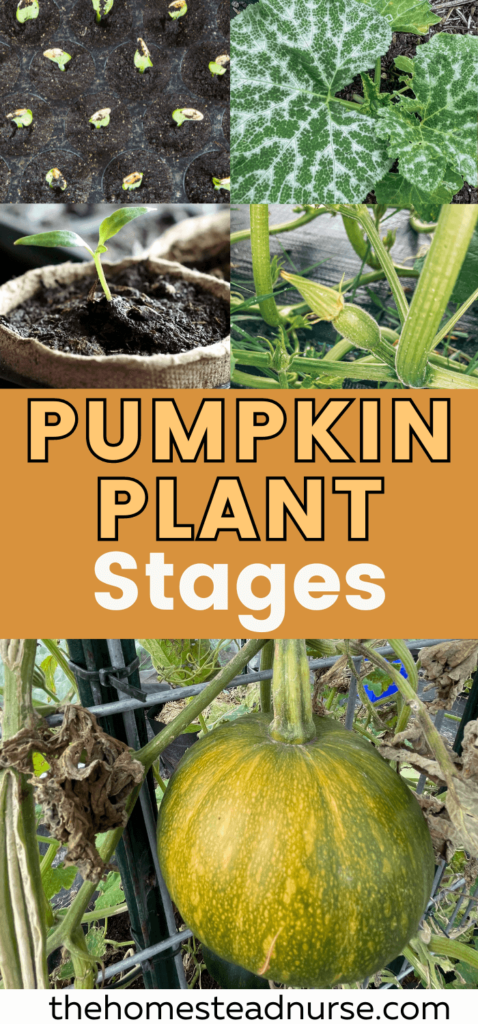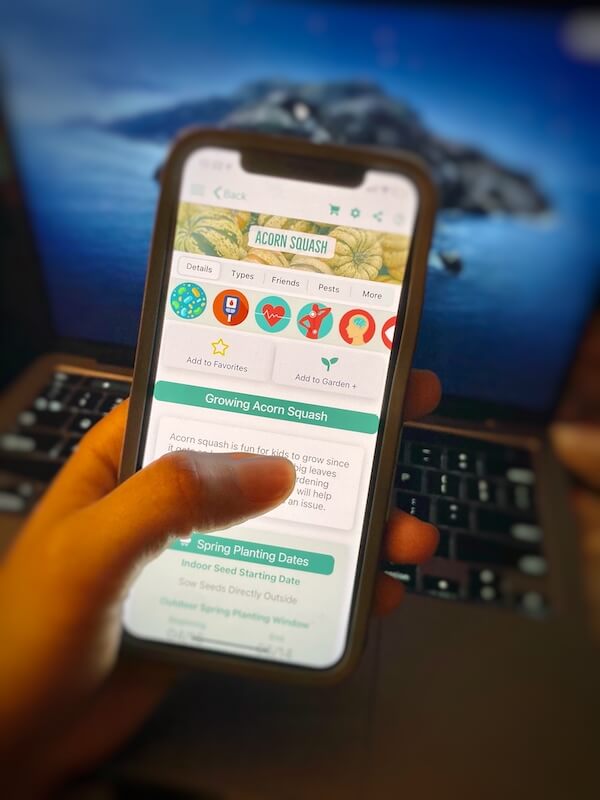The Best Guide on Pumpkin Plant Stages from Seed to Harvest
If you growing pumpkins or are interested in all the pumpkin plant stages, well you are in the right place.
This post about the different stages of pumpkin growth may contain affiliate links, as an Amazon Associate I earn from qualifying purchases. Please read my Disclaimer for more information.
Here we will take you through all the pumpkin growing stages and what to expect and see while a pumpkin grows.
Pumpkins are not only used for food but you can decorate and use them for crafts.
Growing pumpkins is an exciting thing to do and the long almost 90 to 120 days you get to harvest your very own pumpkins.

Pumpkins are a symbol of fall, one of the funniest holidays Halloween, and from some is seen as a symbol of childhood.
I remember when I was younger getting excited to go to a pumpkin patch, picking my own pumpkin to later crave with my family.
Knowing pumpkin plant stages is amazing to see.
Pumpkin Plant Stages Table of Contents
The good thing about pumpkins, you can grow them in almost every climate as long as you give your plant enough space to grow.
Pumpkins are also very diverse because there are so many different varieties of pumpkins you can grow.
Below I will show you the amazing growth and pumpkin plant stages and will know the pumpkin life cycle by the end of this post.
Pumpkin Plant Stages from Seed to Harvest
Stage 1 Days 1-7
Selecting and sowing Pumpkin seeds

Pumpkin seeds are big seeds and can be easily planted without any special treatment to the seed itself.
You can plant pumpkin seeds directly in the soil outside or start them indoors.
If directly sowing seeds in the ground pick a sunny spot with well-draining soil.
Place all types of pumpkin seeds at least 1 inch down into the soil.
I do not do this but it is an option to soak pumpkin seeds in warm water for a few hours or overnight before planting to help speed up germination.
This step can be beneficial but is not necessary.
- Wait until after the last frost date in your area before planting pumpkin seeds. Soil temperature should be around 70°F (21°C).
- Plant pumpkin seeds spaced about 6-8 feet apart to allow ample room for the sprawling vines.
- Plant 2-3 seeds per mound or space them 2-3 feet apart in rows.
- Keep the soil consistently moist, but avoid overwatering.
- Add a layer of mulch to help retain soil moisture and control weeds.
Recommended pumpkin seed varieties.
To help with buying seeds check out The Best Seed Companies List to Help you Grow the most Amazing Garden Ever!
Stage 2
Germinate seeds Days 1-10

This is the first vision of life starting for your pumpkin plant.
- Pumpkin seeds typically germinate within 5-10 days, but this can vary depending on temperature and soil conditions.
- Pumpkin seed germination begins when seeds are in well-draining soil (70-95°F). You will see pumpkin sprouts with the help of some source of heat underneath.
- If starting seeds indoors I recommend getting a heat mat to place under your seeds to help germination.
- Adequate moisture, full sun, and proper spacing are essential.
- Fresh pumpkin seeds have a higher germination rate.
- Use seeds from healthy, mature pumpkins for the best results.
- Seeing your speak of green popping out of yourself is a great feeling and never gets old.
The process begins when the pumpkin seed absorbs water and swells, leading to the leaves that are also called seedling coming up from the soil.
If you need some help starting seeds indoor check out Starting seeds indoors: Ultimate Beginner Guide.
Stage 3
Seeding growth of True leaves Days 10-120

After your pumpkin seedling comes up from the surface the first leaves, called cotyledons can be seen.
You can tell the cotyledon’s “first true leaves,” can look nice and green with the help of photosynthesis.
If you started your pumpkin seeds indoors or in seed trays, you may choose to transplant them into the garden or larger pots once they have at least two sets of true leaves.

Don’t forget to plant your young pumpkin plants that already have true leaves outside after a threat of frost has passed.
Stage 4 Days 20-50
Root system development

Pumpkin plants focus on producing more leaves and developing robust root systems after their true leaves come up.
Continue to provide consistent moisture to your pumpkin plants. Use a balanced, slow-release fertilizer to promote healthy vegetative growth.
Water deeply and avoid overwatering, as this can lead to root rot.
Using drip tape is a great way to water deeply and help the root system establish.
Pumpkin Vines start to grow

Pumpkin plants are known for their sprawling long vines and rapid vine growth.
As they grow, the vines extend and be part of a covered area.
Vines continue to grow rapidly if they get consistent moisture from the plants.
Use a balanced, slow-release fertilizer to promote healthy vegetative growth.
Water deeply and avoid overwatering, as this can lead to root rot.
Stage 5 Days 30-60
Growth of flower blossoms

Pumpkin plants begin to produce large, showy bright yellow flowers.
The female pumpkin flowers that you will see are either male or female flowers.

Male flowers have a straight stem and will get a lot of them growing all around the vines since they might show up first.
My personal experience the first flowers I see are male on a young pumpkin plant in my vegetable garden.
You can tell you looking at a male flower because it will not have a pumpkin at the base of the flower.

Pumpkin female flowers have a small fruit (baby pumpkin) at the base and sometimes female blossoms will open up one week after the first male flower opens.
Pollination
Bees and other pollinators play a crucial role in transferring pollen from male to female flowers.
Adequate pollination is essential for fruit development.
You can also hand-pollinate if necessary by transferring pollen using a small brush or cotton swab.

To self-pollinate pumpkin flowers:
- Identify a male flower with pollen and a female flower with an immature fruit.
- Pick a male flower, remove its petals to expose the stamen (with pollen), and gently rub it onto the stigma (inside the female flower).
- This transfers pollen, aiding in self-pollination that will make pumpkins.
Stage 6 Days 50-100
Fruit Development, Growth & Support

After successful pollination, the first initial fruit is small and will slowly grow bigger.
As the fruit develops, it draws nutrients from the plant and vine.
The baby pumpkins will grow pretty fast during this stage and will change in size and color, turning from green to their final color of orange or whatever variety final color you growing.

- When your pumpkins get bigger you may have to give them some support.
- You can place the vines and pumpkins on a trellis and give them a soft sling or net.
- If on the ground you can place a mesh bag to help prevent the fruit from touching the ground, reducing the risk of rot and pests.
If you have trouble with wildlife eating your fruit you can place a cage around it or shape chicken wire around the pumpkin for protection.
Stage 7 Days 90-120
Ripening of pumpkin

As your pumpkins mature, their color continues to change.
First, you will see your pumpkin’s color will start off as a green color and have soft skin. As they mature, they undergo several changes:
- Color Transition: Pumpkins gradually change from green to their final color, typically orange, although other varieties can be white, yellow, or even striped.
- Skin Hardening: The skin becomes tougher and less shiny, indicating that the pumpkin is maturing.
- Stem Harden: The stem that connects the pumpkin to the vine hardens as the fruit ripens.
- Sweetening and Flavor Development: The flesh inside the pumpkin becomes sweeter and develops its characteristic flavor.
- Maturation Time: The entire process generally takes 90 to 120 days from planting, depending on the pumpkin variety and growing conditions.

The skin becomes harder and less shiny.
The pumpkin’s stem hardens and will stay connected to the pumpkin by the vine.
The stem will harden as the fruit matures showing that the pumpkin is approaching readiness for harvest.
Proper harvesting at the right stage of ripeness ensures that pumpkins are flavorful and have good storage qualities.
Stage 8 Days 90-130
Harvesting

Harvesting a mature pumpkin at the right time is important to ensure they are flavorful and have good storage qualities.
Here’s how to harvest pumpkins:
Harvest pumpkins when they reach full maturity, typically between 90 to 120 days after planting, depending on the pumpkin variety and growing conditions.
They should have a uniform color and a hard skin.
- First look at the pumpkin stem and check the stem where it connects to the pumpkin. If the stem is hard, and woody it is ready for harvest. If the stem is green and pliable, the pumpkin needs more time on the vine.
- Use clean, sharp knife or garden shears to cut the pumpkin from the vine. Leave a few inches of stem attached to the fruit. This stem not only acts as a handle but also helps prolong the pumpkin’s shelf life.
- Cut the pumpkin from the vine using sharp, clean shears or a knife. Leave a few inches of stem attached to the fruit. This stem helps prolong the pumpkin’s shelf life.
- Handle the harvested pumpkins gently to avoid bruising or damaging the skin.
- If you have danger of frost is imminent and your pumpkins are not fully ripe, you may need to harvest them early to prevent damage.

Pre-mature pumpkins harvest time is earlier because of cold weather may not store as long but can still be used.
Pumpkins that are still turning color will finish maturing off the vine with no problem.
Stage 9 Days 130-onward
After the Harvest & Storage

After you have harvested your pumpkins you can cure them if you like but you do not have to.
If you do cure it can enhance their flavor and extend their shelf life.
Here’s how to cure pumpkins:
- Pick pumpkins at full maturity with a hard skin and woody stem.
- Remove dirt and debris by gently wiping the pumpkins with a damp cloth.
- Place the pumpkins in a warm, dry area with good ventilation. Ideally, maintain a temperature of around 80°F (27°C).
- You should cure for about 10 Days and leave the pumpkins in this environment for about a week to 10 days. This allows the skin to harden and minor injuries to heal.
- Be sure to check your pumpkins regularly and inspect them during curing for any signs of mold or rot. Remove any affected pumpkins.
After curing, store the pumpkins in a cool, dry place for long-lasting quality.
Again curing enhances flavor and helps prevent premature spoilage so I would recommend it personally.
Seed Saving
After harvest you can also use some pumpkins to save seeds from.
If you plan to save pumpkin seeds for the next season, scoop out the seeds from the pumpkin, clean them, and let them dry completely before storing them in a cool, dry place.
Composting

Don’t forget to compost any pumpkin scraps or unused portions. They make excellent additions to compost piles.
Storing pumpkins
- Store pumpkins in a cool, dry location with good air circulation.
- Properly cured and stored pumpkins can last several months.
- Avoid direct sunlight and moisture.
- Store on shelves or wooden surfaces, not directly on concrete, to prevent moisture absorption.
- Check for any signs of rot regularly.
- Understanding the pumpkin growth stages of a pumpkin plant’s life cycle allows you to care for your plants effectively and maximize your harvest.

With the right conditions and care, you can enjoy the beauty of growing pumpkins in your garden and reap the rewards of delicious, homegrown pumpkins for various culinary uses and seasonal decor.
If you like pumpkin plant stages below are more fruit and vegetable posts below.
25 Fruits & Best Vegetables for Vertical Gardening
How to Start Pepper Plants from Seeds
Best Guide on How to Grow Sweet Potatoes in Florida
PIN FOR LATER

Don’t forget to spread the ❤️ Love & Share this Post!






